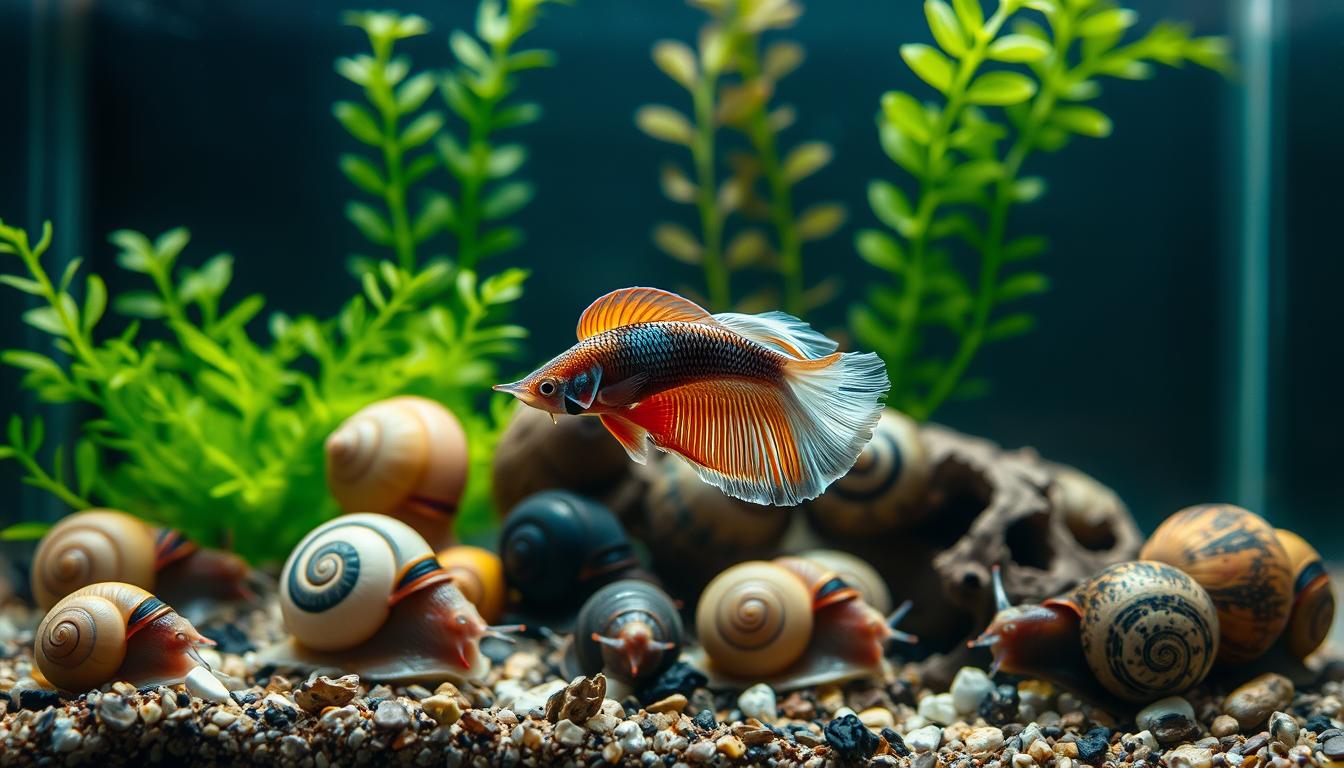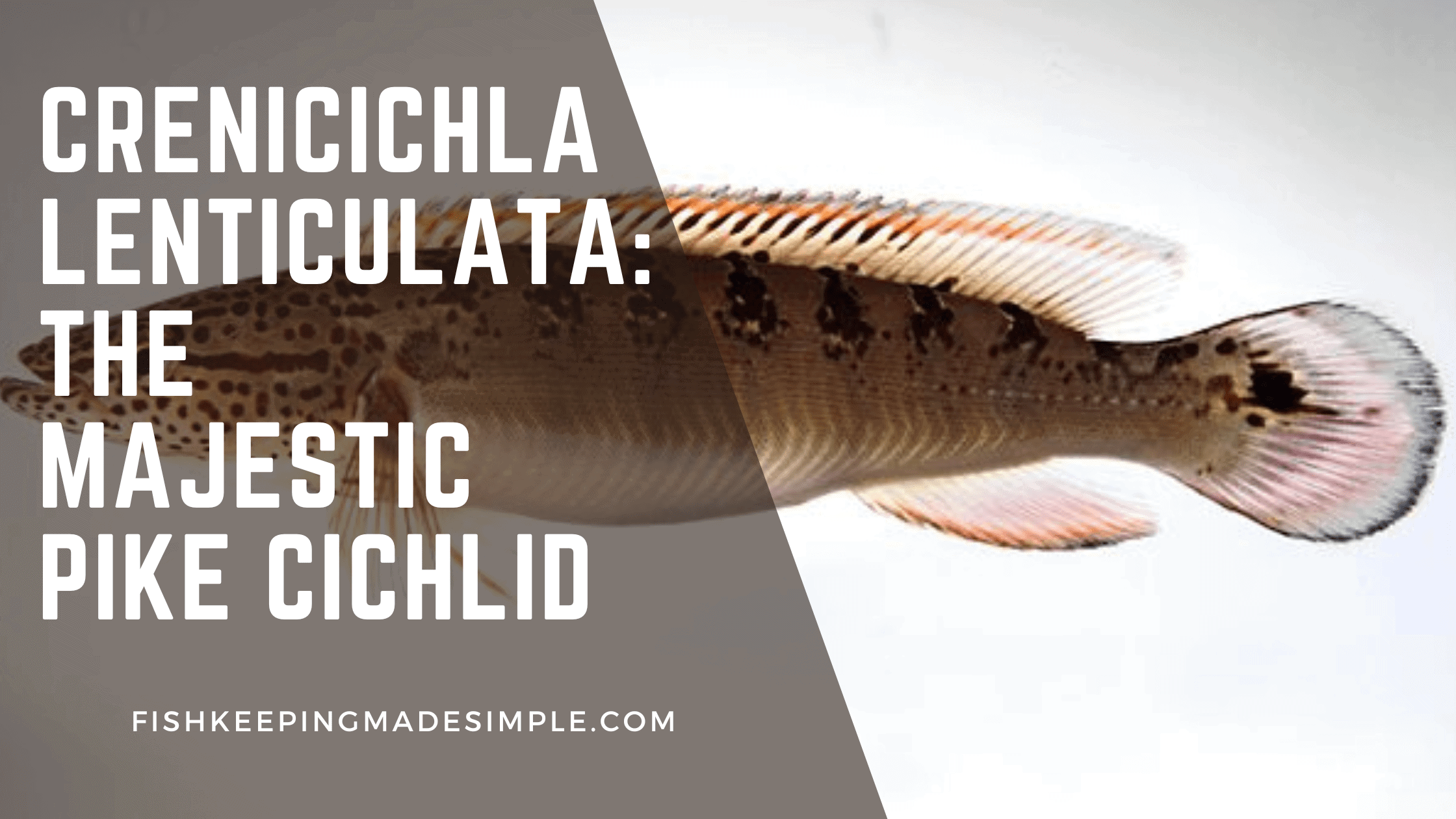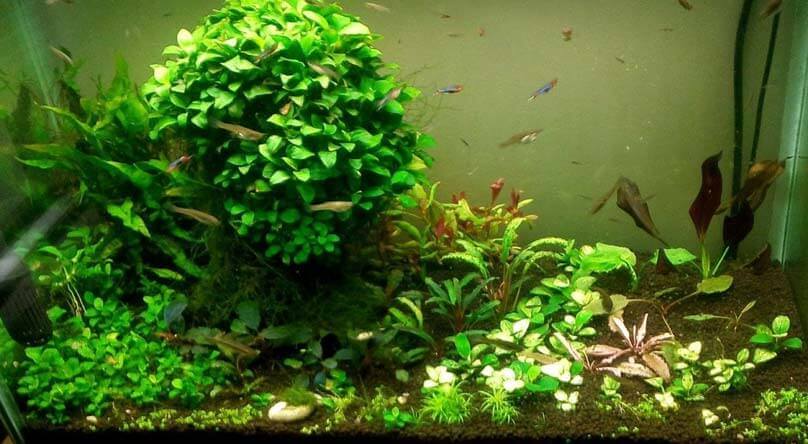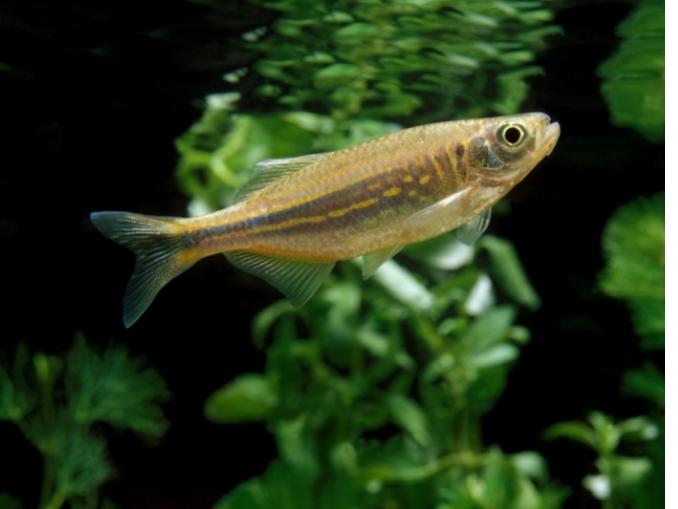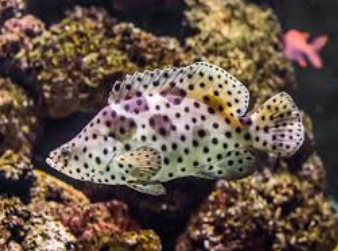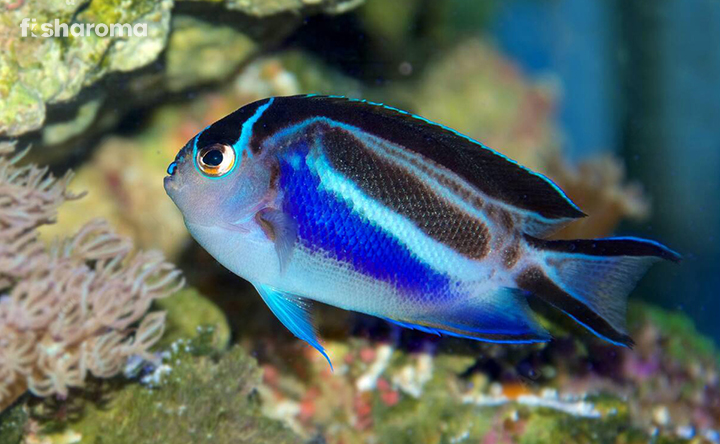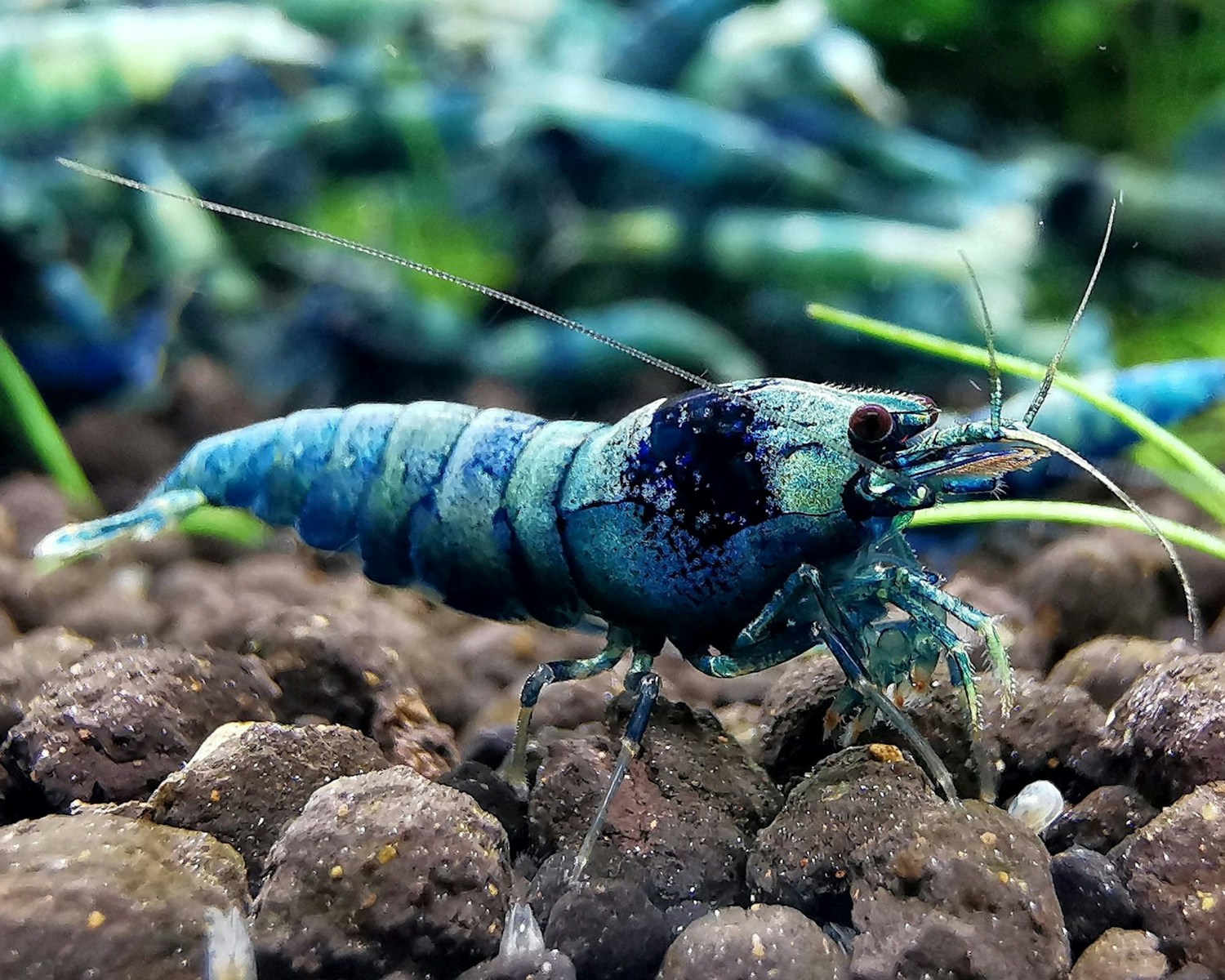Did you know 90% of aquarists have bettas and snails living together successfully? This shows that a peaceful underwater world is possible in your betta tank. We’ll find out which snails can live with bettas and how to keep your tank thriving.
Bettas like to be alone, but the right snails can make your tank lively. I’ll share tips on picking snails that get along with bettas. This way, your tank will be a peaceful home for everyone.
We’ll look at snails like mystery and nerite snails as great tank mates for bettas. I’ll cover their care, what they eat, and how they help your tank. Let’s explore how betta and snail pairs can make a beautiful underwater world.
Table of Contents
Key Takeaways
- Most bettas can coexist peacefully with snails in the same tank
- Snails help maintain tank cleanliness by eating algae and debris
- Mystery snails and nerite snails are popular choices for betta tanks
- Proper tank size and setup are key for betta-snail pairings
- Snails add diversity and natural beauty to your aquarium
- Picking the right snail species prevents overcrowding
- Watching your tank closely keeps both bettas and snails healthy
Understanding Betta Fish Behavior and Compatibility
Choosing the right betta fish tank mates requires knowing betta behavior. Bettas have unique personalities that affect how they get along with others. Let’s look at the main points of betta behavior to help you make a peaceful aquarium.
Territorial Nature of Bettas
Bettas are very territorial. In a 10-gallon tank, they might fight with other fish. I suggest a 20-gallon or bigger tank to reduce fights and keep the water clean.
This extra space lets bettas have their own area while living with peaceful snails for bettas.
Natural Habitat Requirements
To make a great home for bettas and their friends, keep the water between 76°F and 81°F. The pH should be 6.5 to 7.5. Adding live plants helps by giving places for bettas and snails to hide.
Betta Temperament Assessment
Female bettas are usually less aggressive than males, making them better tank mates. But, every betta is different. I recommend slowly introducing new tank mates and watching your betta’s reactions.
Some good tank mates for bettas include Corydoras catfish, neon tetras, and certain snails. Even though some bettas are peaceful, they can get aggressive. Be ready to change the tank or separate fish if needed. Understanding these points helps you create a happy home for your betta and its friends.
Benefits of Adding Snails to Your Betta Tank
Adding snails to your betta tank has many advantages. Snails are great for keeping your tank clean. They help maintain a healthy environment for your betta.
Natural Algae Control
Snails are like nature’s cleaning crew. They eat algae, keeping your tank clean with little effort. Some owners say snails make their tanks so clean, they hardly need to use algae scrubbers.
This natural control helps prevent algae-related health issues in bettas.
Water Quality Improvement
Snails help improve water quality by eating uneaten fish food and waste. This reduces harmful substances like ammonia. But, snails also produce waste, so you might need to change the water more often in smaller tanks.
Tank Ecosystem Enhancement
Snails make your tank ecosystem more diverse and balanced. They help aerate the substrate, increasing oxygen levels. Most snail species are peaceful, making them great tank mates for bettas.
With proper care, snails can live well with your betta. They enhance both the look and health of your aquarium.
| Snail Type | Size (inches) | Lifespan (years) | Recommended Tank Size (gallons) |
|---|---|---|---|
| Mystery Snail | 1.5 – 2 | 1 – 2 | 15+ |
| Nerite Snail | 0.5 – 1 | 1 – 2 | 5+ |
| Assassin Snail | 2 – 3 | 2 | 5+ |
| Rabbit Snail | 2+ | 2 – 3 | 5+ |
What Snails Can Live with Bettas
Several snail species can live well with bettas, making great tank mates. They can live in the same water as bettas and help with algae and aeration. Let’s look at some snails that can live peacefully with your betta fish.
Not all snails are good for betta tanks. Some are better because of their size, behavior, and needs. Here are some popular snails that can live with your betta:
| Snail Species | Size | pH Range | Temperature Range |
|---|---|---|---|
| Nerite Snails | 0.25-0.5 inches | 7.5 | 72-78°F (22-26°C) |
| Mystery Snails | 2 inches | 7.0-7.5 | 68-82°F (20-27°C) |
| Malaysian Trumpet Snails | 1.5 inches | 6.5-8.0 | 70-80°F (22-27°C) |
| Ramshorn Snails | 1 inch | 7.0-7.5 | 65-80°F (18-27°C) |
These snails are calm and can live with bettas. They keep the tank clean by eating algae and leftover food. Make sure your betta tank is at least 5 gallons to fit both species comfortably.
Mystery Snails: The Perfect Betta Companion

Mystery snails are great friends for betta fish, making them a top pick for betta tanks. They are peaceful and help keep the tank clean. This makes them perfect tankmates.
Physical Characteristics
Mystery snails come in many colors like blue, dark, cream, and yellow. Their shells should be strong and without cracks. Healthy snails move well and have no damage to their tentacles or eyes.
Care Requirements
Mystery snails need the right tank to live well with bettas. A 5-gallon tank with pH 7.0-7.5 and 68-82°F temperature is best. It’s important to acclimate them slowly to avoid stress.
Make sure the tank lid is on and water levels are right. This stops them from trying to escape.
Feeding Habits
Mystery snails are great at cleaning the tank. They eat algae, leftover fish food, and betta pellets. This keeps the water clean and reduces the need for frequent tank cleaning.
They live about a year, making them good, short-term friends for your betta.
Nerite Snails: Small but Mighty Cleaners
Nerite snails are great for betta tanks because they are small and clean well. They are perfect for eating algae, making your betta’s home clean and beautiful. These snails are tiny but pack a big punch in keeping your tank clean.
There are many types of Nerite snails, each with its own look. The Olive Nerite is about ½ inch, while Horned and Zebra snails can grow up to 1 inch. They like water between 72°F and 78°F, which is good for bettas too. They also prefer a pH of 7.5 to 8.5 and moderate to high water hardness.
Here are some tips for adding Nerite snails to your betta tank:
- Start with one Nerite snail for every 5 gallons of water
- Make sure your tank is at least 20 gallons for the best results
- Change 10-20% of the water every week to keep it clean
- Don’t use copper-based treatments because they are harmful to snails
Nerite snails are mostly active at night and are great at eating algae. They lay eggs in freshwater, which helps prevent too many snails. With the right care, they can live over two years, making your betta’s home even better.
Malaysian Trumpet Snails: Substrate Specialists

Malaysian Trumpet Snails are fascinating freshwater snails for betta tanks. They are nocturnal creatures that bring unique benefits to your aquarium. They are excellent snail cleaners for betta aquariums, working tirelessly beneath the surface.
Nocturnal Behavior
These snails burrow into the substrate during the day. At night, they emerge to feed on algae and leftover food. This helps keep your tank clean without disturbing your betta’s daytime activities.
Breeding Considerations
Malaysian Trumpet Snails reproduce quickly. A single snail can have up to 100 offspring. It’s important to monitor their numbers to prevent overcrowding.
Tank Maintenance Impact
These snails are great at aerating the substrate. They burrow through the sand or gravel, preventing compaction and promoting healthy bacterial growth. Their waste also acts as natural fertilizer for live plants.
| Characteristic | Detail |
|---|---|
| Size | Up to 1.5 inches |
| Optimal pH | 6.5 – 8.0 |
| Temperature Range | 70-85°F (21-29°C) |
| Minimum Tank Size | 5 gallons |
| Diet | Detritivore (algae, debris) |
Malaysian Trumpet Snails are hardy and adaptable, making them ideal for betta tanks. Their nocturnal habits and ability to clean the substrate contribute greatly to a healthy aquarium environment.
Tank Setup Requirements for Betta-Snail Combinations
Setting up a tank for betta fish and snails needs careful planning. I’ll show you what’s needed for a great betta and snail home.
Optimal Tank Size
For a good home, a bigger tank is better. I suggest a tank of at least 5 gallons. This size lets your betta swim and gives space for snails too.
| Tank Size | Betta Fish | Snails |
|---|---|---|
| 5 gallons | 1 | 1-2 |
| 10 gallons | 1 | 2-4 |
| 15+ gallons | 1 | 4-6 |
Water Parameters
Keeping the water right is key for snails and Betta Fish. The temperature should be 78-80°F and pH should be about 7.0. Also, changing the water often keeps the tank clean and healthy.
Hiding Places and Decor
Bettas like places to hide, and snails enjoy exploring. Add live plants, driftwood, and ceramic decorations. These provide shelter and make a natural home for your fish and snails.
A well-thought-out tank setup is important for a peaceful home for your betta and snails. By following these tips, you’ll make a happy and thriving environment for both.
Feeding and Care Guidelines
Keeping snails and bettas together needs a balanced diet. Feed bettas 2-4 pellets or flakes every day. Add high-protein treats like frozen bloodworms once or twice a week. Snails should get 2-3 meals a week, depending on what they find in the tank.
It’s key to keep the water right for both. The temperature should be between 76°F and 80°F. pH levels should be between 6.5 to 7.5. Regular water changes and a good filter help keep the water clean.
The tank size is important for a healthy home for bettas and snails. Aim for at least 10 gallons. This size helps manage water quality and keeps both species stress-free.
| Parameter | Ideal Range |
|---|---|
| Temperature | 76°F – 80°F |
| pH | 6.5 – 7.5 |
| Ammonia | 0.0 PPM |
| Nitrite | 0.0 PPM |
| Nitrate |
Don’t overfeed, as it can harm the water quality and lead to too many snails. Watch for signs of stress in both. If they’re not active or eating well, it might mean the water isn’t good enough.
Potential Challenges and Solutions
Keeping snails with bettas can be tricky. Knowing the problems and having solutions can help keep your tank healthy for both.
Population Control
Some snails breed fast, which can fill your tank too quickly. I control this by not overfeeding and removing egg clusters. For Malaysian Trumpet Snails, using snail traps or removing them during water changes works well.
Aggression Management
Bettas can be territorial. To lessen aggression towards snails, I add lots of hiding spots with plants and decorations. This keeps snails safe from bettas. I also watch their interactions closely, mainly when introducing snails.
Health Monitoring
It’s important to check the health of both bettas and snails regularly. I look for signs of illness like lethargy in bettas and shell damage in snails. Keeping the water quality right helps prevent many health problems.
| Challenge | Solution |
|---|---|
| Snail overpopulation | Limit feeding, remove egg clusters |
| Betta aggression | Create hiding spots, monitor interactions |
| Health issues | Regular checks, maintain water quality |
By tackling these challenges early, you can make a great home for your betta and snail friends. Remember, what snails can live with bettas depends on your tank and the fish’s personality.
Best Practices for Introduction and Acclimation
Adding peaceful snails to your aquarium needs careful planning. I’ll show you how to introduce these helpful creatures to your tank.
Start by preparing your tank. Make sure the water is right for both bettas and snails. The pH should be 7 to 8, and the temperature 65°F to 83°F. A 10-gallon tank is best for a betta-snail community.
To introduce snails, use the floating method. Put them in a sealed bag and let it float in the tank for 15 minutes. This helps the temperature match.
Then, open the bag and add tank water slowly. Do this every few minutes for about an hour. This helps the snails get used to the new water.
After acclimation, release the snails gently into the tank. Turn off the lights for at least four hours to reduce stress. Watch how your betta and the snails interact closely in the first few days. If there’s aggression, separate them.
Snails are sensitive to changes. A two-week quarantine is good to prevent diseases. With the right acclimation, your tank will be peaceful and thriving.
Conclusion
Exploring what snails can live with bettas, I found that the right companions are key. Mystery snails, nerite snails, and Malaysian trumpet snails are great for betta fish. They live peacefully and help keep the tank clean.
Remember, snails need proper care in a betta tank. Ramshorn snails do well in 5-gallon tanks with temperatures between 68-82°F. They like a pH of 7.0-7.5. Assassin snails prefer similar temperatures but a pH of 7.0-8.0. Both types help control algae and keep the water clean.
Adding snails to a betta tank needs careful planning. Watch how fast ramshorn snails grow. Assassin snails, ready to breed at six months, can control pest snails. With the right balance and conditions, both bettas and snails can live happily together.
FAQ
Are snails safe to keep with betta fish?
How many snails can I add to my betta tank?
Will my betta eat the snails?
Do snails help keep the betta tank clean?
What should I feed snails in a betta tank?
Can snails reproduce too quickly in a betta tank?
What water parameters are suitable for both bettas and snails?
How do I introduce snails to my betta tank safely?
Are there any snails I should avoid keeping with bettas?
How can I tell if my betta and snails are getting along?
References
| Source Name | URL |
|---|---|
| Pomacea bridgesii – Wikipedia | https://en.wikipedia.org/wiki/Pomacea_bridgesii |
| Pomacea diffusa – Wikipedia | https://en.wikipedia.org/wiki/Pomacea_diffusa |
| Viviparidae – Wikipedia | https://en.wikipedia.org/wiki/Viviparidae |
| Viviparus georgianus – Wikipedia | https://en.wikipedia.org/wiki/Viviparus_georgianus |
I am a passionate aquarist with over 30 years of hands-on experience in fishkeeping. My journey began at a young age, collecting fish from the wild and learning through experimentation. Specializing in tropical fish, I bring a deep understanding of the hobby to FishKeepingMadeSimple. The site provides honest, detailed reviews of essential products and accessories to help fellow enthusiasts create the best environments for their fish.

